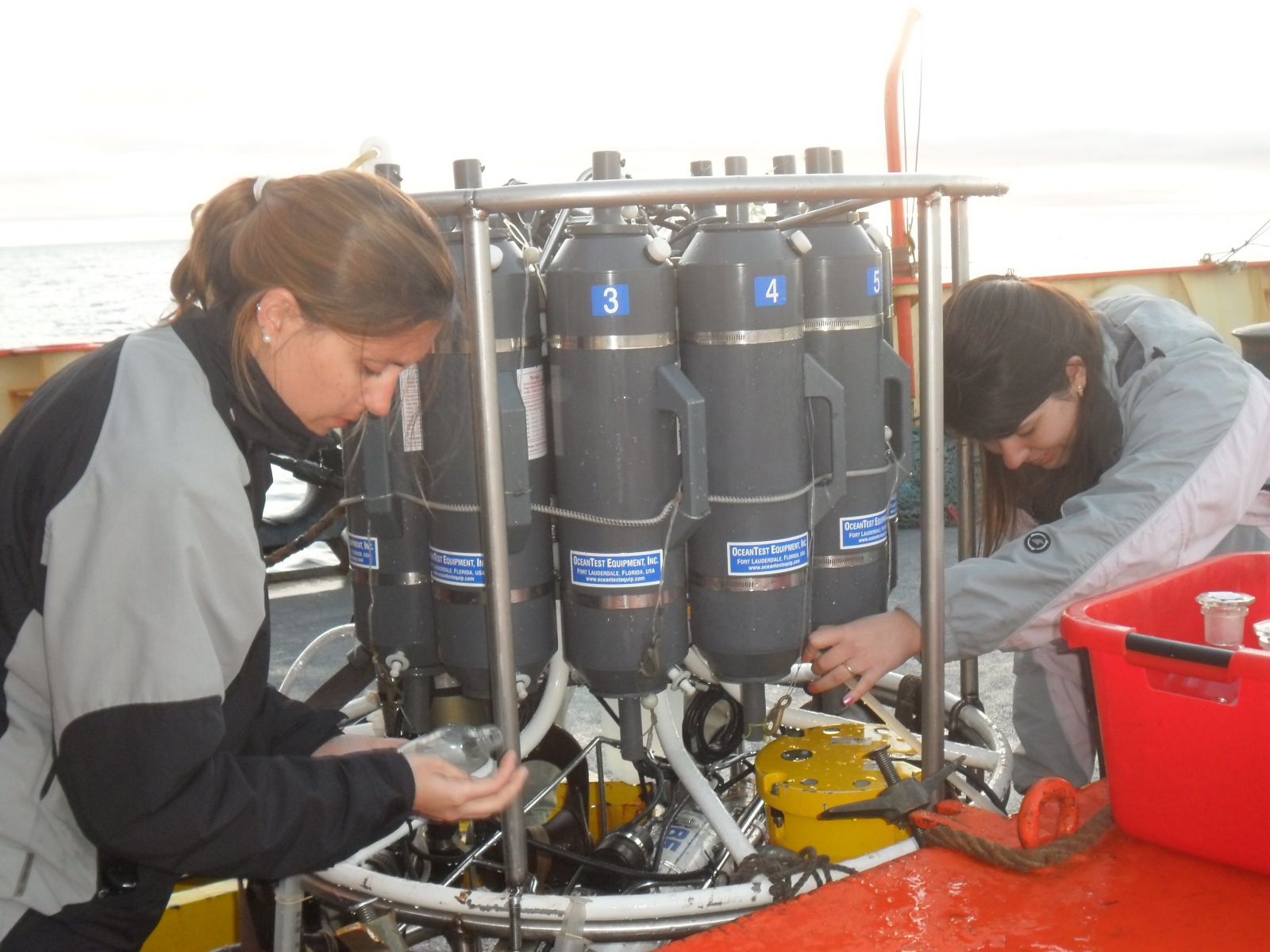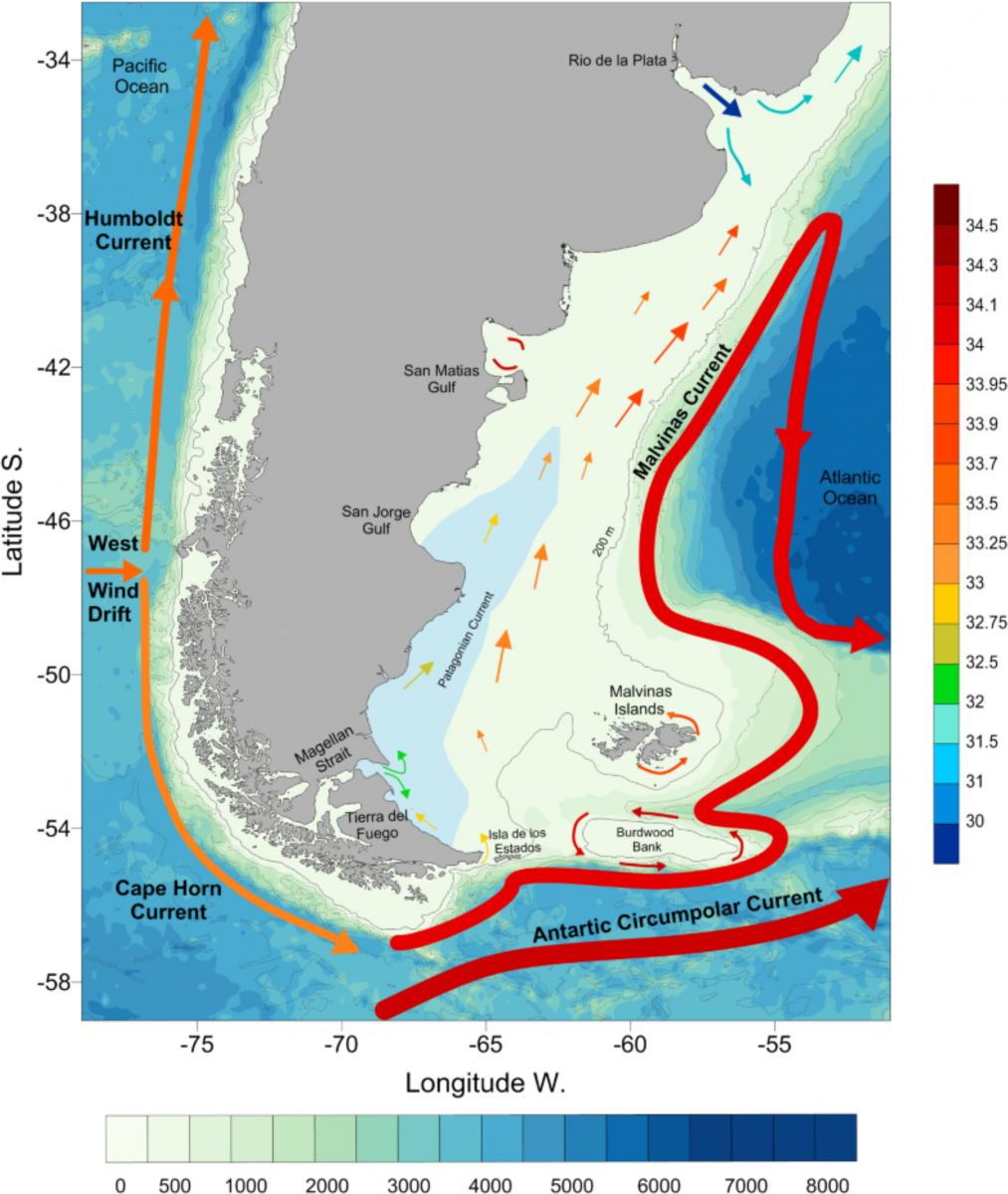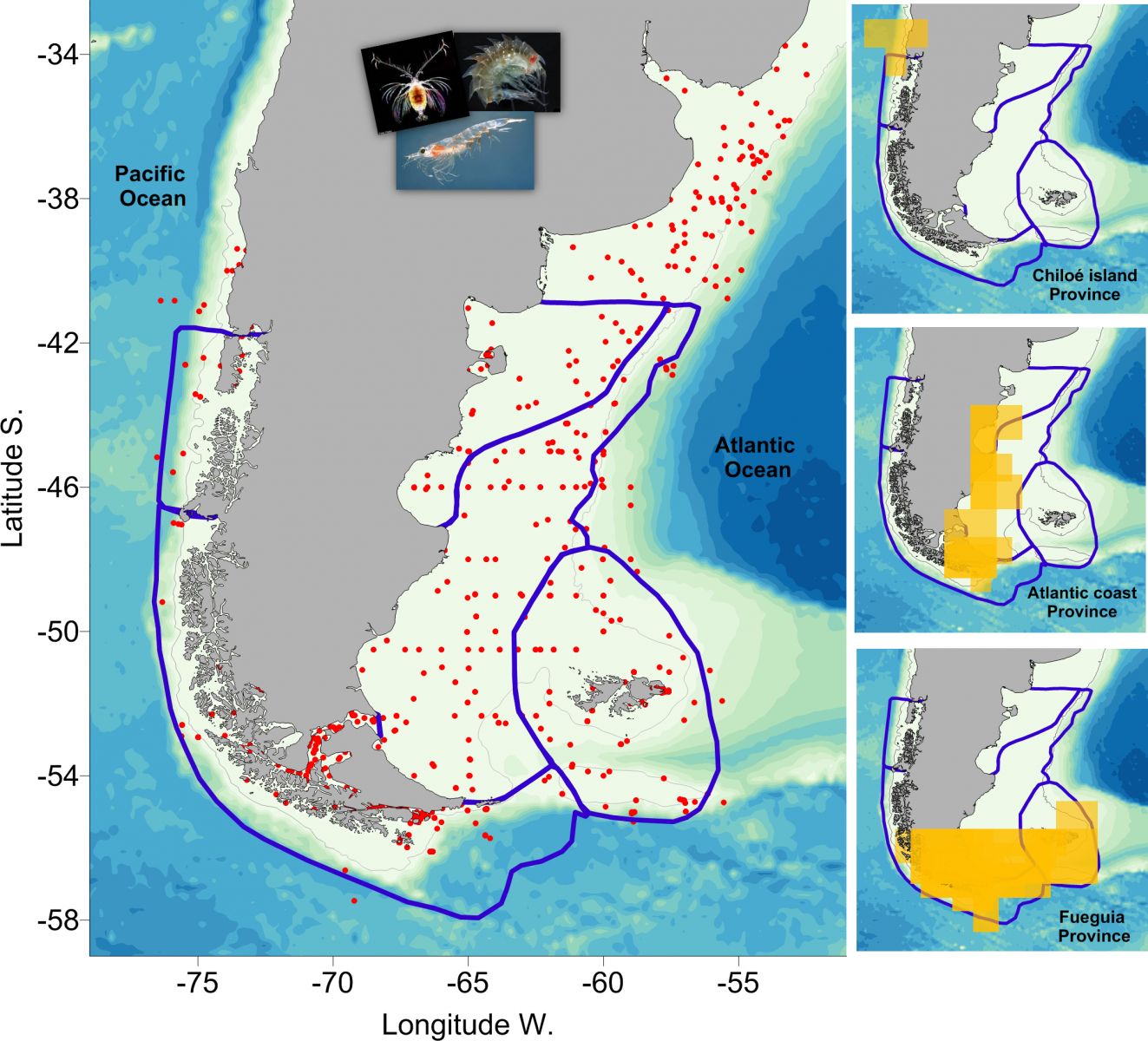Ocean management for sustainable fisheries and conservation along the coasts of southern South America: complex key research challenges for the region
The Namuncurá-Burdwood Bank, Yaganes, and Diego Ramírez-Drake Passage marine protected areas of Argentina and Chile are home to an impressive array of biological diversity. Many of the species identified can only be found in this part of the world. The coasts that surround them are bound by the Humboldt (Pacific) and the Patagonia (Atlantic) large marine ecosystems. Together, these large marine ecosystems or “LMEs” regulate the coastal climate, host rich marine biodiversity and provide significant fisheries and aquaculture resources. Understanding these ecosystems interchanges is key to improve governance strategies and requires collaborative international research.
Three recently published studies investigate the connectivity of these marine ecosystems from oceanographic and biogeographic perspectives. These findings would not have been possible without support from the Inter-American Institute for Global Change Research (IAI) and increased international cooperation. These studies provide insights into complex trans-boundary challenges that decision makers must face when considering ocean management, sustainable fisheries and conservation in ocean systems around the world.
The connectivity between LMEs is of fundamental importance because exchanges of water and marine life forms. LMEs provide a number of important ecoservices, including food supply (through fisheries and aquaculture), energy (oil and gas). Many LMEs include marine protected areas (MPAs) which, if properly implemented and managed have the potential to benefit the neighboring open ocean and adjacent LMEs. Though there were assumptions about the exchanges between the southern Humboldt and Patagonia LMEs, three new papers are the first ones to scientifically assess these exchanges and provide quantitative estimates of the exchange, its seasonal and interannual variation, and the main drivers that modulate these changes.
The first study, published in Polar Biology by Brun et al. (2020), reveals the complex spatial distribution of native (endemic) marine crustacean species (Amphipoda, Copepoda, and Euphausiacea). In this study, scientists described for the first time, regions where there are unique groupings of natives species in the Magellan region. This information is important to establish conservation actions needed to preserve vulnerable habitats. This research also provides profound insights into the marine life present in zones that are currently being considered as protected areas for the southern tip of South America, such as Burdwood Bank, Yaganes and Diego Ramirez-Drake passage.
In a second paper, the team of investigators explored the previously unknown patterns and exchange of ocean waters off the continental shelves of southern Argentina and Chile (published in Estuarine Coastal and Shelf Science by Brun et al. (2020). Their findings suggest that the interoceanic change could have a significant impact on biological processes in ecosystems around the southern tip of South America. This study provides the first quantitative estimate of the interoceanic fluxes between the Pacific and Atlantic shelves through the Strait of Magellan, which shapes the thermohaline structure of the southern Atlantic shelf.
Lastly, investigators also made another key discovery: most of the waters occupying the Patagonia LMEs are derived from the southern Humboldt LME. Identifying this water source was important to better understand how changes in the Pacific can affect the Patagonian Shelf. This understanding of the interconnections between the LMEs can inform environmental conservation policies in this region. This study utilized state-of-the-art numerical simulations, and was published in Ocean Science by Guihou et al. (2020).
Below is a discussion between the IAI Directorate and the lead authors of these studies, Dr. Anahí Brun. and Dr. Karen Guihou, about the importance of oceans and marine resources and linkages with resilience to natural disasters and climate change (see SGP-HW-017 for more information).
How has your research helped to identify solutions to create resilience in marine ecosystems?
Dr. Karen Guihou, PhD in Science of the Universe, specialized in regional modeling, postdoctoral researcher at the CONICET (Argentina), currently based in Puertos del Estado (Spain) for the Copernicus Marine Environment Monitoring Service (CMEMS).
The two largest Marine Ecosystems of the Southern Hemisphere are located along the coasts of Chile and Argentina. They host a wide variety of marine life and absorb 1% of the global carbon dioxide intake from the oceans. We know that they share similar biological and environmental features, meaning there are exchanges between the two systems, but little was known about these connections, and how they could be affected by climate change.
Our research aimed to identify the main pathways and entry points of water masses onto the Patagonian shelf, and how they can be affected in the future. We used three decades of numerical simulations. Knowing the water pathways and connections between these two Austral regions is fundamental to identify vulnerable marine areas, to adopt policy measures to protect the sustainability of the ecosystems (defining natural reserves, local fisheries quotas), and to help establish suitable chain of action in case of environmental disaster upstream (e.g. oil spills, escape of invasive species from fish farms).
We demonstrated that the Patagonian shelf waters originate mainly from the Pacific shelf, via the Cape Horn Shelf and the Magellan Strait. Even though the flow through this latter only accounts for 10% of the total inflow, it has a major effect on the salinity on the Atlantic shelf which is important because it plays a role on the coastal dynamics. We observed a link between the outflow through the Magellan Strait and interannual variability of the wind intensity. It is known that wind anomalies are increasing with climate change. This trend is projected to increase into the future, and as a result, the Patagonian shelf may experience an increase of the outflow from the Magellan Strait and consequently a reduction in salinity, which may impact the coastal dynamics and the local ecosystems.
In Austral South America, 70% of marine ecosystems are already overfished, while only 1% are protected. A change in the properties of these critical water masses and pathways as a result of climate change, combined with the overfishing, has the potential to greatly impact marine species highly sensible to changes in their environment. We would expect to see some endemic species on the Patagonian shelf affected by a change of salinity, and other species might change their migratory path because they follow specific ocean water masses.
This, in turn, impacts fisheries and fishing communities and the economy and could also result in a reduction in carbon dioxide intake by the oceans. For this reason, these studies provide valuable information to guide future decisions on ocean management, sustainable fisheries and conservation, to mitigate the impact of climate change and regulate its consequences.
Dr. Anahí Brun, PhD in Oceanography at University of Buenos Aires, specialized in Physical and biological Oceanograph, Biologist with a focus in ecology.
During the development of this research project we established collaborations with a diverse group of international colleagues: Dr. Oscar Pizarro, (Universidad de Concepción, Chile), Dr. Humberto Gonzalez, (Universidad de Valdivia, Chile), Dr. Sergio Roig-Juñet and Lic. Mariana Griotti, (Instituto Argentino de Investigaciones de Zonas, Aridas, Argentina), among others. Investigators brought together expertise from biology, oceanography, ecology and biogeography disciplines helped to improve our knowledge of the interoceanic fluxes between these LMEs, which is essential to better understand and predict their future evolution in response to climate change.
Knowledge of the exchange processes between these continental shelves is essential for us to better understand and predict the future evolution of coastal and marine ecosystems in response to climate change and other perturbations. We hoped that our findings could inform the creation and design of marine protected areas (MPAs) in the southern tip of South America, a key policy instrument for marine conservation.
We identified areas of endemism for the Magellan region based on the distribution of crustacean species (Amphipoda, copepoda, and Euphausiacea). This study revealed the existence of three biogeographical areas and several subareas (districts) providing new insights into zones currently under in MPAs in this region, such as Burdwood Bank, Yaganes, and Diego Ramírez-Drake Passage. It is also worth noting that in compliance with international agreements such as the Convention on Biological Diversity and the 2011-2020 Aichi goals, Argentina has more than 10% of its maritime space protected, ranking among the largest areas worldwide.
These findings contribute to the conservation of biodiversity and critical habitats in the region and can inform management interventions to reduce the impacts of climate change while protecting the provision of ecosystem services.

Collection of water samples for chemical analyses

Schematic representation of the main currents and general surface circulation in the Magellan region. The arrows indicates the salinity distribution at 20 m and the background shading and contours indicate display the bottom topography in meters from GEBCO. (credits, A Brun)

Records of the crustacean species used in the biogeography study of the Magellan Region (red spots). The divisions in blue lines represent biogeographic provinces. Spalding et al. (2007). (credits, A Brun)
Brun, A. A., Griotti, M., Roig-Juñent, S. A., & Acha, M. E. (2020). Biogeographical patterns and areas of endemism for the Magellan region based on the distribution of crustacean species (Amphipoda, Copepoda, and Euphausiacea). Polar Biology, 1-14.
Guihou, K., Piola, A. R., Palma, E. D., & Chidichimo, M. P. (2020). Dynamical Connections between Large Marine Ecosystems of Austral South America based on numerical simulations, Ocean Science, 16, 271–290.
Brun, A.A., N. Ramírez, O. Pizarro & A.R. Piola, (2020) The role of the Magellan Strait on the southwest South Atlantic shelf, Estuarine, Coastal and Shelf Science, 237, 106661.
References
Falabella, V., Campagna, C., and Croaxall, J. P. (2009). Atlas del Mar Patagonico. Especies y espacios. Wildlife Conservation Society, BirdLife International, Buenos Aires.
Heileman, S. (2009). XVI-55 Patagonian Shelf: LME #14. In Sherman, K. and Hempel, G., editors,
The UNEP Large marine Ecosystem Report: A perspective on changing conditions in LMEs of the world’s Regional Seas., number 182 in UNEP Regional Seas Report and Studies, pages 735–746, United Nations Environment Programme. Nairobi, Kenya.
Kahl, L. C., Bianchi, A. A., Osiroff, A. P., Pino, D. R., and Piola, A. R. (2017). Distribution of sea-air CO 2 fluxes in the Patagonian Sea: Seasonal, biological and thermal effects. Continental Shelf Research, 143:18–28.
Marshall, G., Orr, A., van Lipzig, N. P. M., and King, J. C. a. (2006). The Impact of a Changing Southern Hemisphere Annular Mode on Antarctic Peninsula Summer Temperatures. Journal Of Climate, 19:5388–5404.
Spalding, M. D., Fox, H. E., Allen, G. R., Davidson, N., Ferdan ̃a, Z. A., Finlayson, M., Halpern, B. S., Jorge, M. A., Lombana, A., Lourie, S. A., Martin, K. D., McManus, E., Molnar, J., Recchia, C. A., and Robertson, J. (2007). Marine ecoregions of the world: A bioregionalization of coastal and shelf areas. BioScience, 57(7):573–583.
Referencias
Acha EM, Mianzan HW, Guerrero RA, Favero M, Bava J (2004) Marine fronts at the continental shelves of austral South America. J Mar Syst 44:83– 105
Balech E, Ehrlich MD (2008) Esquema biogeográfico del Mar Argentino. Rev Inv Des Pesq 19:45–75
Boschi, E.E (2000) Species of decapod Crustaceans and their distribution in the American marine zoogeographic provinces. Rev. Inv. Des. Pesq 13:7-136.
Escribano R, Fernández M, Aranís A (2003) Physical-chemical processes and patterns of diversity of the chilean eastern boundary pelagic and benthic marine ecosystems: an overview. Gayana 67:190–205
Heileman, S (2009) XVI-55 Patagonian Shelf LME. In, Sherman, K. and Hempel, G. (Eds.). The UNEP Large marine Ecosystem Report: A perspective on changing conditions in LMEs of the world's Regional Seas. UNEP Regional Seas Report and Studies N°182. United Nations Environment Programme. Nairobi, Kenya, 735-746
Palma, S (2006) Distribución y abundancia de zooplancton en canales y fiordos australes. pp.107-113. En: Avances en el conocimiento oceanográfico de las aguas interiores chilenas, Puerto Montt a cabo de Hornos, N. Silva & S. Palma (eds.), PUCV, 162 pp.
